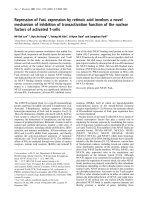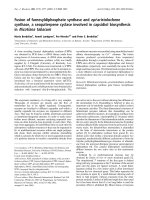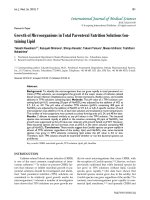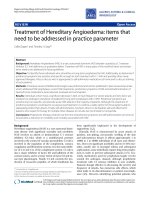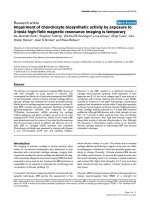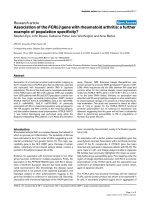Báo cáo y học: "Susceptibilities of medaka (Oryzias latipes) cell lines to a betanodavirus" docx
Bạn đang xem bản rút gọn của tài liệu. Xem và tải ngay bản đầy đủ của tài liệu tại đây (3.31 MB, 7 trang )
Adachi et al. Virology Journal 2010, 7:150
/>Open Access
RESEARCH
© 2010 Adachi et al; licensee BioMed Central Ltd. This is an Open Access article distributed under the terms of the Creative Commons
Attribution License ( which permits unrestricted use, distribution, and reproduction in
any medium, provided the original work is properly cited.
Research
Susceptibilities of medaka (
Oryzias latipes
) cell lines
to a betanodavirus
Kei Adachi, Kosuke Sumiyoshi, Ryo Ariyasu, Kasumi Yamashita, Kosuke Zenke and Yasushi Okinaka*
Abstract
Background: Betanodaviruses, members of the family Nodaviridae, have bipartite, positive-sense RNA genomes and
are the causal agents of viral nervous necrosis in many marine fish species. Recently, the viruses were shown to infect a
few freshwater fish species including a model fish medaka (Oryzias latipes). Although virological study using cultured
medaka cells would provide a lot of insight into virus-fish interactions in molecular aspects, no such cells have yet been
tested for virus susceptibility.
Results: We tested ten medaka cell lines for susceptibilities to redspotted grouper nervous necrosis virus (RGNNV).
Although the viral coat protein was detected in all the cell lines inoculated, the levels of cytopathic effect development
and viral propagation were quite different among the cell lines. Those levels were especially high in OLHNI-1 and
OLHNI-2 cells, but were extremely low in OLME-104 cells. Some cell lines entered into antiviral state after RGNNV
infections probably because of inducing an antiviral system. This is the first report to examine the susceptibilities of
cultured medaka cells against a virus.
Conclusion: OLHNI-1 and OLHNI-2 cells are candidates of new standard cells for betanodavirus study because of their
high susceptibilities to the virus and their several advantages as model fish cells.
Background
Betanodaviruses, members of the family Nodaviridae, are
small non-enveloped viruses with a genome composed of
a bipartite single-stranded, positive-sense RNA [1,2]. The
larger genomic segment, RNA1 (3.1 kb), encodes the
RNA-dependent RNA polymerase and the smaller
genomic segment, RNA2 (1.4 kb), encodes the coat pro-
tein (CP) [2]. During viral RNA replication, a subgenomic
RNA3 is produced, which encodes the RNA interference
inhibitor protein B2 [3-5]. Betanodaviruses are classified
basically into four genotypes based on the phylogenetic
analysis of their genomic RNA2 sequences [6-8]. These
genotypes are striped jack nervous necrosis virus
(SJNNV), barfin flounder nervous necrosis virus
(BFNNV), tiger puffer nervous necrosis virus (TPNNV)
and redspotted grouper nervous necrosis virus
(RGNNV). Recently, a betanodavirus isolate from turbot
(Scophthalmus maximus) was suggested to belong to a
fifth genotype [9].
Betanodaviruses are the causative agents of a highly
destructive disease of marine fish designated viral ner-
vous necrosis. The viruses have been isolated from a large
number of marine fish species [10,11]. Betanodaviruses
propagate in various established cell lines derived from
not only fish [2,12] but also mammals [13]. Recently, it
was revealed that larvae of freshwater fish guppy (Poicelia
reticulata) [14] and tilapia (Oreochromis niloticus) [15]
were affected naturally by RGNNV. Some freshwater fish
including medaka (Oryzias latipes) [16,17] and zebrafish
(Danio rerio) [18] are lethally susceptible to betanodavi-
ruses under experimental conditions. Medaka has several
experimental advantages as a model fish compared to
other fish and higher vertebrates. For example, medaka is
small, cost-effective, easy to breed in large numbers, and
has a short life cycle. Furthermore, whole medaka
genomic sequences are available and many experimental
techniques for gene function analysis can be applied to
medaka [19,20]. However, one obstacle to study betanod-
avirus-medaka interactions in molecular aspects is the
lack of cultured medaka cells which are susceptible to a
betanodavirus. Therefore, in this study, we examined the
* Correspondence:
1
Graduate School of Biosphere Science, Hiroshima University, Higashi-
hiroshima 739-8528, Japan
Full list of author information is available at the end of the article
Adachi et al. Virology Journal 2010, 7:150
/>Page 2 of 7
susceptibilities of ten medaka cell lines derived from dif-
ferent strains and organs to RGNNV.
Results
Virus infection and cytopathic effect (CPE) development
We firstly examined the infectivity of RGNNV against the
medaka cell lines (Table 1) by detecting CP-expressing
cells at 1 day post-inoculation (dpi). When the cells were
inoculated with RGNNV having the 50% tissue culture
infectious dose (TCID
50
) of 10
6
, most of the inoculated
cells expressed the CP in OLHNI-1, OLHNI-2, and OLK-
aga-e1 cells (Figure 1). In contrast, quite a small number
of cells expressed the CP in OLF-136 and OLME-104
cells (Figure 1). The typical CPE, represented as rounded
cells which were finally detached from the dish, was
detected only in OLHNI-1 and OLHNI-2 cells at 1 dpi of
10
5
or 10
6
TCID
50
of RGNNV (data not shown). To exam-
ine further whether the eight cell lines other than
OLHNI-1 and OLHNI-2 cells exhibit CPE by RGNNV-
inoculations, inoculated cells were incubated for up to 7
days and observed under a microscope (Figure 2).
OLHNI-2 cells showed the apparent CPE at 2 dpi when
the cells were exposed to 10
3
TCID
50
of RGNNV and
almost detached from the dish at 3 dpi (Figure 2).
OLHNI-1, OLHE-131, OLKaga-e1, and OLHdrR-e3 cells
also showed apparent CPE in 4-5 days after inoculated
with 10
3
TCID
50
of virus (data not shown). In contrast, no
apparent CPE was observed in OLCAB-e31, OLME-104,
OLCAB-e21, or OLF-136 cells (Figure 2, data not shown
for the latter two) within 7 days even though the cells
were exposed to 10
6
TCID
50
of virus. These results indi-
cate that OLHNI-1 and OLHNI-2 cells are highly suscep-
tible to RGNNV compared with the other cell lines.
Furthermore, RGNNV production and/or spread seem to
be restricted in some of the medaka cell lines though the
Table 1: Medaka cell lines used in this study
Cell line Species Strain Tissue derived
OLHNI-1 Oryzias latipes HNI Caudal fin
OLHNI-2 O. latipes HNI Caudal fin
OLHE-131 O. latipes H04C Liver
OLKaga-e1 O. latipes Kaga Embryo
OLHdrR-e3 O. latipes Hd-rR Embryo
OLCAB-e3 O. latipes Cab Embryo
OLCAB-e21 O. latipes Cab Embryo
OLCAB-e31 O. latipes Cab Embryo
OLF-136 O. latipes Unknown Fin
OLME-104 O. latipes HB32C Melanoma
Figure 1 Infectivity of RGNNV in various medaka cell lines. Each
cell line (1.0-1.5 × 10
5
cells) was inoculated with 10
5
or 10
6
TCID
50
of
RGNNV and incubated at 30°C. Viral coat protein in infected cells was
detected by indirect immunofluorescence assay at 1 dpi. Cell nucleus
was stained with 4', 6-diamino-2-phenylindole (DAPI). Data represents
the merged image of Alexa488-fluorencence and DAPI staining.
Adachi et al. Virology Journal 2010, 7:150
/>Page 3 of 7
virus can multiply in all of the cell lines to a varying
degree.
Virus spread
To examine whether RGNNV spread occur in the
medaka cell lines which lacked clear appearance of CPE
(Figure 2), we examined CP-expressing cells in those cell
lines inoculated with RGNNV. In OLCAB-e21 and
OLCAB-e31 cells, the numbers of CP-expressing cells
were decreased dramatically with time (Figure 3) com-
pared with those at 1 dpi (Figure 1). In OLF-136 cells, the
number of CP-expressing cells was increased transiently
at 3 dpi (Figure 3) compared to that at 1 dpi (Figure 1) but
then decreased gradually. No virus spread was observed
in OLME-104 cells throughout the experimental period
(Figures 1 and 3). These results indicate that the viral
spread was tightly limited in the four cell lines, which
resulted in the defect of apparent CPE development as
shown in Figure 2.
Production of progeny virus
In DBT cells which are derived from murine astrocy-
toma, RGNNV propagated efficiently without substantial
increases in the number of virus-infected cells and CPE-
exhibiting cells [13]. These data suggest that a great
amount of RGNNV production is not necessarily con-
cerned with the number of virus-infected cells and
appearance of CPE. To quantify progeny virus from inoc-
ulated medaka cells, we calculated the viral titers in the
culture supernatant by the TCID
50
method (Table 2). The
viral titers of the culture supernatant from infected
OLHNI-1 and OLHNI-2 cells increased sequentially and
reached more than 10
9
TCID
50
/ml at 5 dpi. Similarly, the
maximum viral titers were approximately: 10
8
TCID
50
/ml
in OLHE-131, OLKaga-e1, and OLHdrR-e3 cells; 10
7
TCID
50
/ml in OLCAB-e3, OLCAB-e31, and OLF-136
cells; 10
6
TCID
50
/ml in OLCAB-e21 cells. The viral titers
of the supernatant from inoculated OLME-104 cells did
Figure 2 CPE development in RGNNV-infected medaka cells. The cells (1.0-1.5 × 10
5
) were inoculated with RGNNV of the indicated titers and cul-
tured at 30°C. Cell morphology of the RGNNV-inoculated or mock-inoculated cells was observed at 1-3 dpi for OLHNI-2 cells and at 3-7 dpi for OLCAB-
e31 and OLME-104 cells.
Adachi et al. Virology Journal 2010, 7:150
/>Page 4 of 7
Figure 3 Restriction of RGNNV spread among medaka cells. (A) The cells (1.0-1.5 × 10
5
) were inoculated with 10
6
TCID
50
of RGNNV and cultured
at 30°C. The CP and cell nucleus in the infected cells were detected by indirect immunofluorescence assay and DAPI staining, respectively, at the in-
dicated period. Data represents the merged image of Alexa488-fluorescence and DAPI staining. (B) Rates for the infected cells against the total cells
represented in Figures 1 and 3A were calculated and shown periodically.
&#"!#$ !%$!
!
$#$!$#
Adachi et al. Virology Journal 2010, 7:150
/>Page 5 of 7
not increase during the whole experimental period, sug-
gesting that RGNNV was unable to propagate in this cell.
Interestingly, in E-11 cells, the maximum viral titer was
10
8.1
TCID
50
/ml, which was approximately 10-fold lower
than those of OLHNI-1 and OLHNI-2 cells. These results
indicated that RGNNV multiplies in various medaka cell
lines, especially in OLHNI-1 and OLHNI-2 cells, but
hardly in OLME-104 cells. Furthermore, OLHNI-1 and
OLHNI-2 cells are candidates of new standard cells for
betanodavirus study because of their high susceptibilities
to the virus and their several advantages as model fish
cells.
Discussion
We have demonstrated the susceptibilities of established
medaka cells to the betanodavirus (RGNNV), the levels
of which varied irrespective of the originated tissues.
Medaka cell lines could be classified into three categories
in terms of the infectivity and/or the productivity of
RGNNV in the cells as follows: (1) cells are efficiently
infected by virus, and give CPE and a high titer of prog-
eny virus as is the cases for OLHNI-1, OLHNI-2, OLHE-
131, OLKaga-e1, and OLHdrR-e3 cells, (2) cells are
infected by virus though CPE and viral spread are tightly
limited, which resulted in production of a low amount of
progeny virus as is the cases for OLCAB-e3, OLCAB-e21,
OLCAB-e31 and OLF-136 cells, (3) cells are hardly
infected by virus as is the cases for OLME-104 cells.
There would be two possible processes which determined
the levels of the susceptibilities to RGNNV. One is the
presence or absence of cellular factors required for
RGNNV infection, such as cell-specific receptors. The
other is the presence or absence of cellular factors which
repress RGNNV infection. With regard to the former
possibility, fibronectin 2 of zebrafish (Danio rerio) is the
only cellular factor which has so far been identified for
fish viruses. Zebrafish fibronectin 2 mediates infectious
hematopoietic necrosis virus attachment and cell entry
[21]. Cell-surface sialic acid is involved in binding of
RGNNV to SSN-1 cells and other cellular molecules are
required along with sialic acid for RGNNV penetration
into some human cell lines [22,23]. However, such a cellu-
lar molecule essential for betanodavirus infection has not
yet been identified. OLME-104 cells were severely less
susceptible to RGNNV (Figure 1), suggesting the lacks of
specific cellular factors for RGNNV. Meanwhile, OLHNI-
1 and OLHNI-2 cells were highly susceptible to RGNNV
(Figure 1), suggesting that these cell lines possess a posi-
tive cellular factor for betanodavirus infection. With
respect to the latter possible mechanism, the culture
supernatant of OLME-104 cells included an antiviral sub-
stance that protected some of the medaka cell lines from
RGNNV-infection (authors' unpublished data). These
results indicate that OLME-104 cells produce an inter-
feron-like signal molecule irrespective of viral infection,
which brings themselves into antiviral state. Further-
more, these data also indicate that some medaka cells
Table 2: Betanodavirus propagation in the medaka cell lines
Cell line
Inoculum
a
(TCID
50
) Viral titer (TCID
50
/ml)
b
Day 1 Day 3 Day 5 Day 7
OLHNI-1
10
3
4.4 × 10
4
± 1.2 × 10
4
4.9 × 10
8
± 7.0 × 10
7
1.8 × 10
9
± 7.5 × 10
8
NT
OLHNI-2
10
3
4.0 × 10
4
± 0 4.0 × 10
8
± 1.7 × 10
8
1.4 × 10
9
± 4.0 × 10
8
NT
OLHE-131
10
3
3.3 × 10
3
± 7.5 × 10
2
4.4 × 10
7
± 1.2 × 10
7
2.6 × 10
8
± 6.0 × 10
7
NT
OLKaga-e1
10
3
4.0 × 10
3
± 0 2.9 × 10
8
± 3.5 × 10
7
3.2 × 10
8
± 8.5 × 10
7
NT
OLHdrR-e3
10
3
4.8 × 10
3
± 8.0 × 10
2
1.9 × 10
8
± 1.0 × 10
7
2.9 × 10
8
± 3.5 × 10
7
NT
OLCAB-e3
10
6
2.9 × 10
5
± 3.5 × 10
4
2.1 × 10
7
± 4.0 × 10
6
2.5 × 10
7
± 1.5 × 10
7
3.6 × 10
7
± 4.0 × 10
6
OLCAB-e21
10
6
5.1 × 10
4
± 1.9 × 10
4
4.1 × 10
6
± 1.6 × 10
6
3.7 × 10
6
± 1.9 × 10
6
1.9 × 10
6
± 1.3 × 10
6
OLCAB-e31
10
6
3.6 × 10
5
± 4.0 × 10
4
5.6 × 10
6
± 0 5.6 × 10
6
± 0 7.8 × 10
6
± 2.2 × 10
6
OLF-136
10
6
1.1 × 10
5
± 6.9 × 10
4
4.8 × 10
6
± 8.0 × 10
5
7.8 × 10
6
± 2.2 × 10
6
2.1 × 10
7
± 1.1 × 10
7
OLME-104
10
6
4.8 × 10
4
± 8.0 × 10
3
4.8 × 10
4
± 8.0 × 10
3
3.6 × 10
4
± 4.0 × 10
3
3.6 × 10
4
± 4.0 × 10
3
E-11
10
3
2.7 × 10
4
± 1.3 × 10
4
1.4 × 10
8
± 1.3 × 10
8
1.4 × 10
8
± 4.0 × 10
7
NT
a. Medaka cells and E-11 cells (1.0-1.5 × 10
5
) were inoculated with RGNNV of the indicated titers.
b. Viral titers in the culture supernatant were determined by the TCID
50
assay using E-11 cells at 30°C.
Each data represents the mean and standard deviation from two independent experiments.
NT, Not tested.
Adachi et al. Virology Journal 2010, 7:150
/>Page 6 of 7
used in this study are sensitive to such a defense signal
molecule.
The OLCAB-e21, OLCAB-e31, and OLF-136 cells
infected by RGNNV produced sufficient amounts of
infectious virus particles in the culture supernatant
(Table 2) though the levels of CPE and viral spread were
tightly limited (Figures 2 and 3). These characteristics
suggest that the cells entered into antiviral states after
viral infections. Similar to mammalian Mx proteins, fish
Mx proteins also possess type I interferon (IFN)-induc-
ible antiviral activity in vitro and in vivo [24-27]. Grouper
(Epinephelus coioides) Mx proteins inhibited the propa-
gation of RGNNV in the grouper brain cells [28]. In addi-
tion, the BB cell line derived from the brain of
barramundi (Lates calcarifer) was infected persistently
with RGNNV and this viral persistence in BB cells was
well correlated with the expression of Mx gene [29,30].
Thus, an IFN-like substance might be produced in the
culture supernatant of the RGNNV-infected OLCAB-
e21, OLCAB-e31, and OLF-136 cells, which induces the
cells into antiviral states. However, Mx gene expression
was detected by RT-PCR in OLCAB-e31 cells inoculated
with RGNNV, not in inoculated OLCAB-e21 or OLF-136
cells (authors' unpublished data). These results suggest
that a defense machinery other than the IFN system
works in OLCAB-e21 and OLF-136 cells. Taken together,
a few kinds of defense systems could function to protect
the medaka cells from RGNNV infection.
E-11 cells [12] cloned from SSN-1 cells are infected
latently with snakehead retrovirus (SnRV) [31]. SnRV
regulates positively [32] or negatively [33] the infections
of fish cells with betanodaviruses. In our experiments,
SnRV was detected by RT-PCR in all of the medaka cells
inoculated with RGNNV prepared from infected E-11
cells. However, there was no correlation between suscep-
tibilities of medaka cells to RGNNV and the levels of RT-
PCR signals for SnRV (authors' unpublished data).
Conclusions
In this report, we examined the susceptibility of various
medaka cell lines to RGNNV, and found that RGNNV can
infect and propagate in many kinds of established
medaka cells. Studies on host-betanodavirus interactions
using these medaka cell lines would lead to the identifica-
tion of host factors essential for betanodavirus infections.
Especially, OLHNI-1 and OLHNI-2 cells would be suit-
able for such studies in molecular aspects.
Methods
Cells and viruses
The three medaka cell lines, OLHE-131, OLF-136, and
OLME-104 (Table 1), were purchased from RIKEN BRC
Cell Bank (Tsukuba, Japan). The other seven medaka cell
lines (Table 1) [34] were provided from H. Mitani. All the
medaka cells were cultured at 30°C in Leibovitz's L-15
medium (L-15) (Invitrogen, Carlsbad, CA, USA) contain-
ing 15% fetal bovine serum (FBS). E-11 cells [12] were
cultured in L-15 medium supplemented with 5% FBS.
The betanodavirus used in this study was RGNNV
(SGWak97 strain) [35]. Virus was prepared from the
inoculated E-11 cells when more than 90% of the inocu-
lated cells showed CPE. Viral titers were determined
based on TCID
50
[36] using E-11 cells.
Viral inoculation and multiplication assay
Medaka cells were seeded in 24-well plates and were
inoculated with RGNNV at 30°C for 1 h. For each cell
line, 1.0-1.5 × 10
5
cells were inoculated with 10
3
, 10
5
, or
10
6
TCID
50
of virus. The cells were washed to remove
unbound viral particles and were further cultured at the
same temperature. The culture supernatant was recov-
ered periodically and its viral titer was determined by the
TCID
50
assay as described above.
Immunofluorescence microscopy
Indirect immunofluorescence assay was performed using
inoculated medaka cells as described previously [22].
Briefly, cells were fixed with 4% paraformaldehyde and
permeabilized by treatment with 0.1% NP-40 in PBS. The
cells then were treated with a 1:1000 dilution of anti-
RGNNV CP antiserum, followed by the treatment with a
1:2000 dilution of Alexa Fluor 488 goat anti-rabbit IgG
(Invitrogen), and were observed under the fluorescence
microscope (ORCA-1394 and AQUA-Lite version 1.10
systems; Hamamatsu photonics K. K., Hamamatsu,
Japan).
Competing interests
The authors declare that they have no competing interests.
Authors' contributions
KA participated in design and interpretation of the experiments, performed
the research, and wrote the manuscript. KS and KZ carried out a part of the
virological experiments. RA and KY participated in cell culture and preparation
of the virus sample. YO conceived of the study, and was involved in the design
and cordination. All authors approved the final version of the manuscript.
Acknowledgements
We would like to thank Dr. H. Mitani, The University of Tokyo, for providing the
medaka cell lines. We also would like to express our thanks to Y. Ninomiya,
Medaka Honpo Co., Ltd., for technical assistance of rearing medaka. This work
was supported in part by a grant-in-aid for the Program for Promotion of Basic
and Applied Researches for Innovations in Bio-oriented Industry (BRAIN) and
by a grant-in-aid for Scientific Research (20380111) from the Ministry of Educa-
tion, Culture, Sports, Science and Technology, Japan.
Author Details
Graduate School of Biosphere Science, Hiroshima University, Higashi-hiroshima
739-8528, Japan
Received: 2 June 2010 Accepted: 12 July 2010
Published: 12 July 2010
This artic le is available fro m: http://www.v irologyj.com/co ntent/7/1/150© 2010 Adachi et al; licensee BioMed Central Ltd. This is an Open Access article distributed under the terms of the Creative Commons Attribution License ( which permits unrestricted use, distribution, and reproduction in any medium, provided the original work is properly cited.Virology Journal 2010, 7:150
Adachi et al. Virology Journal 2010, 7:150
/>Page 7 of 7
References
1. Mori K, Nakai T, Muroga K, Arimoto M, Mushiake K, Furusawa I: Properties
of a new virus belonging to nodaviridae found in larval striped jack
(Pseudocaranx dentex) with nervous necrosis. Virology 1992,
187:368-371.
2. Schneemann A, Ball AL, Delsert C, Johnson JE, Nishizawa T: Family
Nodaviridae. In Virus taxonomy Edited by: Fauquet CM, Mayo MA,
Maniloff J, Desselberger U, Ball LA. Academic Press, San Diego;
2005:865-872.
3. Fenner BJ, Goh W, Kwang J: Sequestration and protection of double-
stranded RNA by the betanodavirus b2 protein. J Virol 2006,
80:6822-6833.
4. Fenner BJ, Thiagarajan R, Chua HK, Kwang J: Betanodavirus B2 is an RNA
interference antagonist that facilitates intracellular viral RNA
accumulation. J Virol 2006, 80:85-94.
5. Iwamoto T, Mise K, Takeda A, Okinaka Y, Mori K, Arimoto M, Okuno T,
Nakai T: Characterization of Striped jack nervous necrosis virus
subgenomic RNA3 and biological activities of its encoded protein B2. J
Gen Virol 2005, 86:2807-2816.
6. Nishizawa T, Furuhashi M, Nakai T, Muroga K: Genomic classification of
fish nodaviruses by molecular phylogenetic analysis of the coat
protein gene. Appl Environ Microbiol 1997, 63:1633-1636.
7. Nishizawa T, Mori K, Furuhashi M, Nakai T, Furusawa I, Muroga K:
Comparison of the coat protein genes of five fish nodaviruses, the
causative agents of viral nervous necrosis in marine fish. J Gen Virol
1995, 76:1563-1569.
8. Okinaka Y, Nakai T: Comparisons among the complete genomes of four
betanodavirus genotypes. Dis Aquat Org 2008, 80:113-121.
9. Johansen R, Sommerset I, Torud B, Korsnes K, Hjortaas MJ, Nilsen F,
Nerland AH, Dannevig BH: Characterization of nodavirus and viral
encephalopathy and retinopathy in farmed turbot, Scophthalmus
maximus (L.). J Fish Dis 2004, 27:591-601.
10. Munday BL, Kwang J, Moody N: Betanodavirus infections of teleost fish.
J Fish Dis 2002, 25:127-142.
11. Office International des Epizzoties (OIE): Viral encephalopathy and
retinopathy. In Manual of Diagnostic Tests for Aquatic Animals fifth
edition. Paris: OIE; 2006:169-175.
12. Iwamoto T, Nakai T, Mori K, Arimoto M, Furusawa I: Cloning of the fish cell
line SSN-1 for piscine nodaviruses. Dis Aquat Org 2000, 43:81-89.
13. Takizawa N, Adachi K, Ichinose T, Kobayashi N: Efficient propagation of
betanodavirus in a murine astrocytoma cell line. Virus Res 2008,
136:206-210.
14. Hegde A, Teh HC, Lam TJ, Sin YM: Nodavirus infection in freshwater
ornamental fish, guppy, Poicelia reticulata-comparative
characterization and pathogenicity studies. Arch Virol 2003,
148:575-586.
15. Bigarré L, Cabon J, Baud M, Heimann M, Body A, Lieffrig F, Castric J:
Outbreak of betanodavirus infection in tilapia, Oreochromis niloticus
(L.), in fresh water. J Fish Dis 2009, 32:667-673.
16. Furusawa R, Okinaka Y, Nakai T: Betanodavirus infection in the
freshwater model fish medaka (Oryzias latipes). J Gen Virol 2006,
87:2333-2339.
17. Furusawa R, Okinaka Y, Uematsu K, Nakai T: Screening of freshwater fish
species for their susceptibility to a betanodavirus. Dis Aquat Org 2007,
77:119-125.
18. Lu MW, Chao YM, Guo TC, Santi N, Evensen O, Kasani SK, Hong JR, Wu JL:
The interferon response is involved in nervous necrosis virus acute and
persistent infection in zebrafish infection model. Mol Immunol 2008,
45:1146-1152.
19. Kinoshita M, Murata K, Naruse K, Tanaka M: Medaka; Biology,
Management, and Experimental Protocols Wiley-Blackwell, Iowa. 2009.
20. Taniguchi Y, Takeda S, Furutani-Seiki M, Kamei Y, Todo T, Sasado T,
Deguchi T, Kondoh H, Mudde J, Yamazoe M, Hidaka M, Mitani H, Toyoda A,
Sakaki Y, Plasterk RH, Cuppen E: Generation of medaka gene knockout
models by target-selected mutagenesis. Genome Biol 2006, 7:R116.
21. Liu X, Collodi P: Novel form of fibronectin from zebrafish mediates
infectious hematopoietic necrosis virus infection. J Virol 2002,
76:492-498.
22. Adachi K, Ichinose T, Watanabe K, Kitazato K, Kobayashi N: Potential for
the replication of the betanodavirus redspotted grouper nervous
necrosis virus in human cell lines. Arch Virol 2008, 153:15-24.
23. Liu W, Hsu CH, Hong YR, Wu SC, Wang CH, Wu YM, Chao CB, Lin CS: Early
endocytosis pathways in SSN-1 cells infected by dragon grouper
nervous necrosis virus. J Gen Virol 2005, 86:2553-2561.
24. Gahlawat SK, Ellis AE, Collet B: Expression of interferon and interferon-
induced genes in Atlantic salmon Salmo salar cell lines SHK-1 and TO
following infection with Salmon Alpha Virus SAV. Fish Shellfish Immunol
2009, 26:672-675.
25. Kibenge MJ, Munir K, Kibenge FS: Constitutive expression of Atlantic
salmon Mx1 protein in CHSE-214 cells confers resistance to infectious
salmon anaemia virus. Virol J 2005, 2:75-80.
26. Saint-Jean SR, Perez-Prieto SI: Effects of salmonid fish viruses on Mx gene
expression and resistance to single or dual viral infections. Fish Shellfish
Immunol 2007, 23:390-400.
27. Wu YC, Chi SC: Cloning and analysis of antiviral activity of a barramundi
(Lates calcarifer) Mx gene. Fish Shellfish Immunol 2007, 23:97-108.
28. Lin CH, Christopher John JA, Lin CH, Chang CY: Inhibition of nervous
necrosis virus propagation by fish Mx proteins. Biochem Biophys Res
Commun 2006, 351:534-539.
29. Chi SC, Wu YC, Cheng TM: Persistent infection of betanodavirus in a
novel cell line derived from the brain tissue of barramundi Lates
calcarifer. Dis Aquat Org 2005, 65:91-98.
30. Wu YC, Chi SC: Persistence of betanodavirus in barramundi brain (BB)
cell line involves the induction of interferon response. Fish Shellfish
Immunol 2006, 21:540-547.
31. Frerichs GN, Morgan D, Hart D, Skerrow C, Roberts RJ, Onions DE:
Spontaneously productive C-type retrovirus infection of fish cell lines.
J Gen Virol 1991, 72:2537-2539.
32. Nishizawa T, Kokawa Y, Wakayama T, Kinoshita S, Yoshimizu M: Enhanced
propagation of fish nodaviruses in BF-2 cells persistently infected with
snakehead retrovirus (SnRV). Dis Aquat Org 2008, 79:19-25.
33. Lee KW, Chi SC, Cheng TM: Interference of the life cycle of fish nodavirus
with fish retrovirus. J Gen Virol 2002, 83:2469-2474.
34. Hirayama M, Mitani H, Watabe S: Temperature-dependent growth rates
and gene expression patterns of various medaka Oryzias latipes cell
lines derived from different populations. J Comp Physiol 2006,
176:311-320.
35. Iwamoto T, Mori K, Arimoto M, Nakai T: High permissivity of the fish cell
line SSN-1 for piscine nodaviruses. Dis Aquat Org 1999, 39:37-47.
36. Reed LJ, Muench H: A simple method of estimating fifty per cent
endpoints. Am J Hyg 1938, 27:493-497.
doi: 10.1186/1743-422X-7-150
Cite this article as: Adachi et al., Susceptibilities of medaka (Oryzias latipes)
cell lines to a betanodavirus Virology Journal 2010, 7:150
